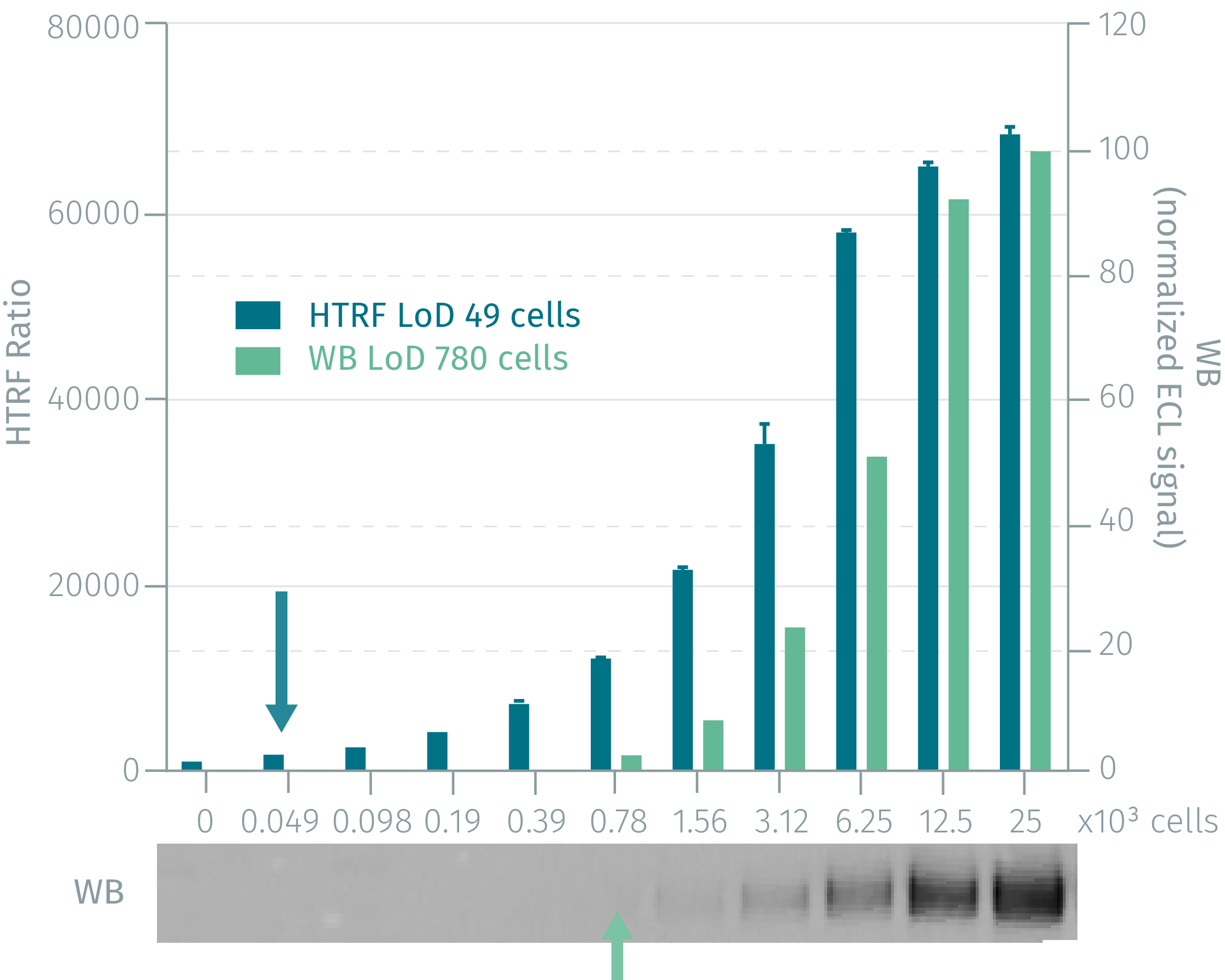

HTRF Human Total EGFR Detection Kit, 500 Assay Points


HTRF Human Total EGFR Detection Kit, 500 Assay Points






The total EGFR kit monitors cellular EGFR expression level and can be used as a normalization assay for the phospho-EGFR kits.
| Feature | Specification |
|---|---|
| Application | Cell Signaling |
| Sample Volume | 16 µL |
The total EGFR kit monitors cellular EGFR expression level and can be used as a normalization assay for the phospho-EGFR kits.



HTRF Human Total EGFR Detection Kit, 500 Assay Points



HTRF Human Total EGFR Detection Kit, 500 Assay Points



Product information
Overview
The Total EGFR cellular assay kit monitors total EGFR and is used as a normalization assay with our phospho-EGFR kits. Mutations that lead to an overexpression or hyperactivity of EGFR, also known as ErbB1 or HER1, are associated with a number of cancers, such as lung, colorectal, prostate, glioblastoma cancer, etc. This makes EGFR a key target for anti-cancer therapy-related immunoassay.
Specifications
| Application |
Cell Signaling
|
|---|---|
| Brand |
HTRF
|
| Detection Modality |
HTRF
|
| Lysis Buffer Compatibility |
Lysis Buffer 3
Lysis Buffer 4
Lysis Buffer 5
|
| Molecular Modification |
Total
|
| Product Group |
Kit
|
| Sample Volume |
16 µL
|
| Shipping Conditions |
Shipped in Dry Ice
|
| Target Class |
Phosphoproteins
|
| Target Species |
Human
|
| Technology |
TR-FRET
|
| Therapeutic Area |
Oncology & Inflammation
|
| Unit Size |
500 Assay Points
|
Video gallery

HTRF Human Total EGFR Detection Kit, 500 Assay Points

HTRF Human Total EGFR Detection Kit, 500 Assay Points

Citations
How it works
Total-EGFR assay principle
The Total-EGFR assay quantifies the expression level of EGFR in a cell lysate. Contrary to Western Blot, the assay is entirely plate-based and does not require gels, electrophoresis or transfer. The Total-EGFR assay uses two labeled antibodies: one coupled to a donor fluorophore, the other to an acceptor. Both antibodies are highly specific for a distinct epitope on the protein. In presence of EGFR in a cell extract, the addition of these conjugates brings the donor fluorophore into close proximity with the acceptor and thereby generates a FRET signal. Its intensity is directly proportional to the concentration of the protein present in the sample, and provides a means of assessing the proteins expression under a no-wash assay format.

Total-EGFR 2-plate assay protocol
The 2 plate protocol involves culturing cells in a 96-well plate before lysis then transferring lysates to a 384-well low volume detection plate before adding Total EGFR HTRF detection reagents. This protocol enables the cells' viability and confluence to be monitored.

Total-EGFR 1-plate assay protocol
Detection of total EGFR with HTRF reagents can be performed in a single plate used for culturing, stimulation and lysis. No washing steps are required. This HTS designed protocol enables miniaturization while maintaining robust HTRF quality.

Assay validation
HTRF total EGFR assay compared to WB
A431 cells were grown in a T175 flask at 37 °C, 5% CO2 for 48h. Cells were then stimulated with 100 nM EGF for 10 min. After medium removal, the cells were lysed with 3mL of supplemented lysis buffer for 30 min at room temperature. Soluble fractions were then collected after 10 min centrifugation. Serial dilutions of the cell lysate were performed in the supplemented lysis buffer and 16 µL of each dilution were dispensed and analyzed side-by-side by Western-blot and by HTRF. By using HTRF total-EGFR only 50 cells are sufficient for minimal signal detection while 780 cells are needed for a Western Blot signal. The HTRF total-EGFR assay is at least 15-fold more sensitive than the Western Blot and shows optimal correlation.


Inhibition measured with Phospho-EGFR (tyr1068) and total EGFR cellular kits
Human epidermoid carcinoma A431 cells were pre-treated for 3 h with a dose-response of Cetuximab, an extracellular therapeutic antibody, then stimulated for 10 min with 200 nM EGF.

Inhibition measured with Phospho-EGFR (Tyr1068) and total EGFR cellular kits
Human pancreatic carcinoma BxPC3 cells were pre-treated for 30 min with a dose-response of ATCC528, an extracellular monoclonal antibody, then stimulated for 10 min with 200 nM EGF

Inhibition measured with Phospho-EGFR (tyr1068) and total EGFR cellular kits
Human epidermoid carcinoma A431 cells were pre-treated for 3h with a dose-response of Gefitinib, a small Tyrosine Kinase Inhibitor, then stimulated for 10 min with 200 nM EGF

Simplified pathway
EGFR epidermal growth factor receptor signaling simplified pathway
EGFR is a receptor tyrosine kinase that belongs to the ErbB family. Binding of EGFR ligands drive receptor homodimerization or hetero-dimerization leading to the activation of the EGFR tyrosine kinase domain and specific tyrosine residues.
The phosphorylated tyrosine residues then provide docking sites for a variety of factors that induce downstream activation of several signal transduction cascades.
The transmitted signals from the EGF receptor to the nucleus lead to the regulation of various biological functions such as cell proliferation, differentiation, survival, adhesion, migration & angiogenesis.
Mutations that lead to overexpression or hyperactivity of EGFR are associated with a number of cancers making EGFR a key target for anti-cancer therapies.

Resources
Are you looking for resources, click on the resource type to explore further.
Discover the versatility and precision of Homogeneous Time-Resolved Fluorescence (HTRF) technology. Our HTRF portfolio offers a...
Loading...


How can we help you?
We are here to answer your questions.




































